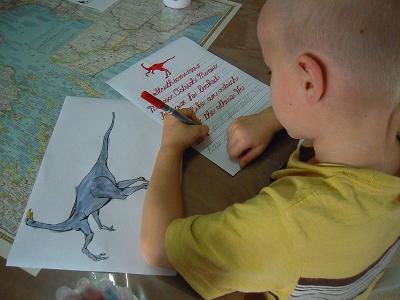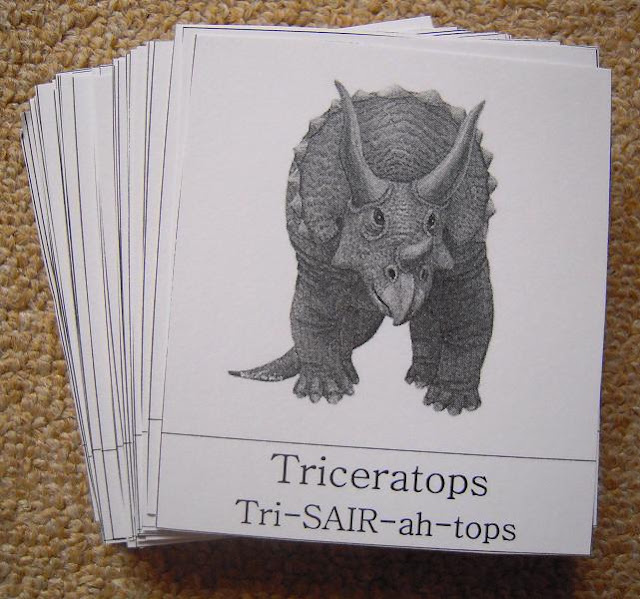Dip painted flowers by Zak
This is our first ever set of lessons on how to paint. I was so impressed with the lesson book (I Can Do All Things) and with my boys! I did not know they could do the nice job they did. They were pleased too. We are interjecting basic art skills lesson in between artist studies/picture studies. So after we finished exploring and getting to know Edgar Degas we learned a bit about basic drawing skills then we got to know Van Gogh, next we began painting 101.
Getting started was not hard, or expensive. I purchased I Can Do All Things along with the paintcards, a set of brushes for each boy, and a set of basic paint colors (red, blue, yellow, white, and black) from How Great thou Art for under $60. Considering I Can Do All Things is a 4 year art curriculum with lesson in, drawing, colored pencils, markers, painting, art history (a little bit) and an art journal introduction it is well worth the $40. I only purchased one book and then a set of paint cards for each of the boys. So in all you only need;
I Can Do All Things Text
Paint cards
Set of primary paints with black and white
set of three sizes of brushes
Tin cans for water
Aprons or old shirts
Dip painted flower by Max.
I have a degree in fine arts which I found did not help me one bit. You forget things as you get older. Also things you do habitually are hard to remember to teach. I found I Can Do All Things a wonderful help to me to remember what fundamentals are important to teach, and what new beginners need to know to be successful. I simply read the lesson word for word out of the book and we attempted to do what he recommended. It was an easy, relaxing and fun seris of lessons for us all.
TJ finishing lesson #1
Lesson #1 is about primary colors.
But before we got into that we learned from our book rules and regulations for painting. I found these so helpful. It kept the boys on track and gave concrete things to do right to have success while painting. Here are some of the things he recommended:
How to set up your painting area so you don't drop your sleeve into you picture.
How to mix paint by adding dark to light.
Have two water container one for dirty and one for clean.
Fill your water only half full so you don't splash.
How to store your brushes.
What size brush to use.
Don't scrub your paint.
How to clean up.
Zak on Lesson #1
Primary Colors Lesson #1
What happens when you mix white to red? Black to red? White to blue? Black to blue? white to yellow? Black to yellow? That is basically the lesson.
Max 'the careful one' is last to finish but his work is precise and well done. Good job Max!
I love that Max mixed up more than on kind of light blue to make his bird more interesting.
TJ is finishing up lesson #2.
Lesson #2 is about Secondary Colors.
Yellow + Red = Orange
Red + Blue = Purple
Blue + Yellow = Green
Then.....what happens if you add white and black to those. That is the lesson.
Max painting.
Color Chart.
Lesson #3 Making a Color Chart
How do you make flesh color? brown? Violet? etc. We were very interested in making flesh tones which isn't all that easy. Brown was difficult too. But it was fun!
Dip painting.
Lesson #4 Dip Painting
What do you do with left over paint? Try dip painting. Dip painting is simply mixing the paints on your picture instead of your palette. It is a great way to use up extra paint and experiment with color too. I love the way it looks in the end, very painterly.
Close up of Zak's dip painted flower.
There are 24 lessons on painting. In this series we only did 4......20 more to go! It was a good start, and a good way to find out what painting is all about. But we have more artist studies to fit in this year so we will be back to paint some more later. On to Monet!
UPDATE 05/06/2011
Lesson #5 Painting With Control
1. Did you stay in the lines?
2. Did you take your time painting?
3. Does your artwork look nice?
Painting with control by TJ.
Lesson #6 Light Side and Shaded Side
Did you know that if you add blue to red it gets darker? or if you add yellow to red it gets lighter? We played around with colors and lighted some sides and darkened others.
Lighte side and shaded side by TJ.
UPDATED 6/3/2011
Lesson #7 Autumn Colors
"Did you ever notice all the different colors of leaves in Autumn? See if you can make some rust colors by adding dull orange to yellow, red, green. A dull orange is yellow plus red and a speck of blue." Barry Stebbing
We mixed several different kinds of fall colors and painted the small leaves at the top of the page with those colors. Then, the boys picked out the color they liked best to paint the larger leaves on the page.
Lesson #8 How Now Brown Cow
Zak's Bunny.
"Brown is an easy color to mix. You should learn how to mix many different kinds of browns because there is so much brown around you....Let's see how many browns you can make with the primary colors." Barry Stebbing.
We discovered that when we mixed secondary colors (orange, green and violet) with a dab of the color missing color (orange would be missing blue) then you get many different browns.
Zak's paint card.
Once we had made a nice brown we played around with lightening and darkening it. Orange with a seck of blue gets lighter when more yellow is added. What happens when we add more red? or more blue?
Zak's cat.
Lesson #9 Tropical Fish
Zak's fish with tropical colors we made using lots and lots of white.
Max's Fish.










































